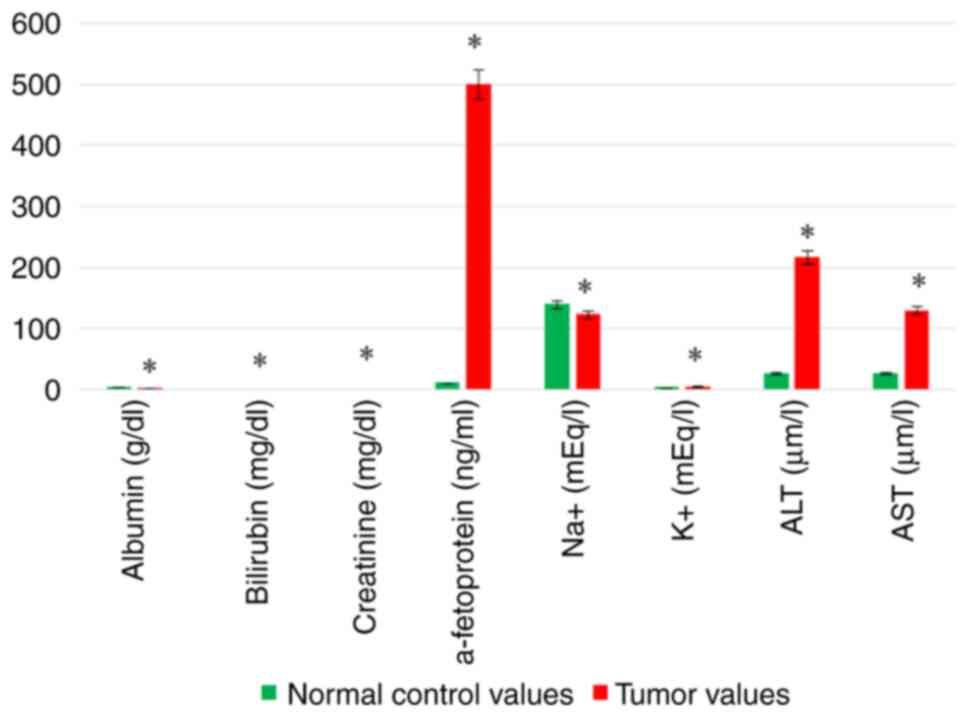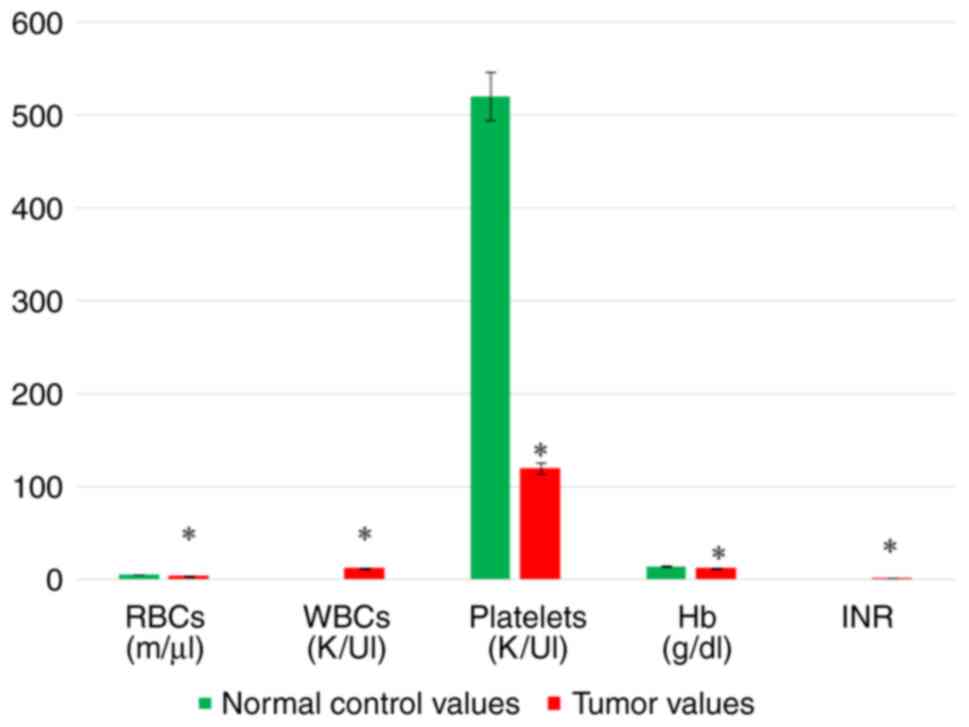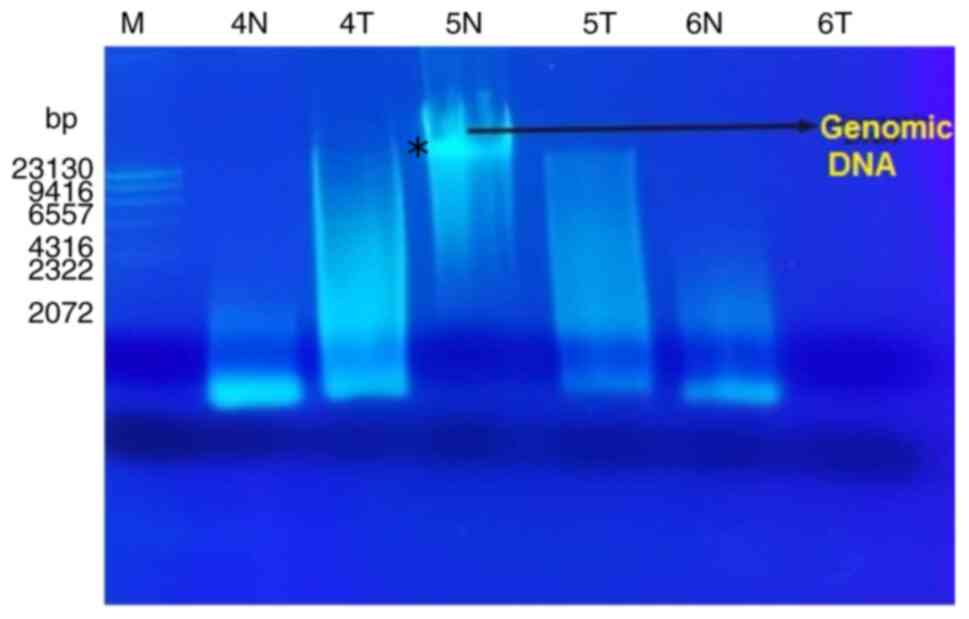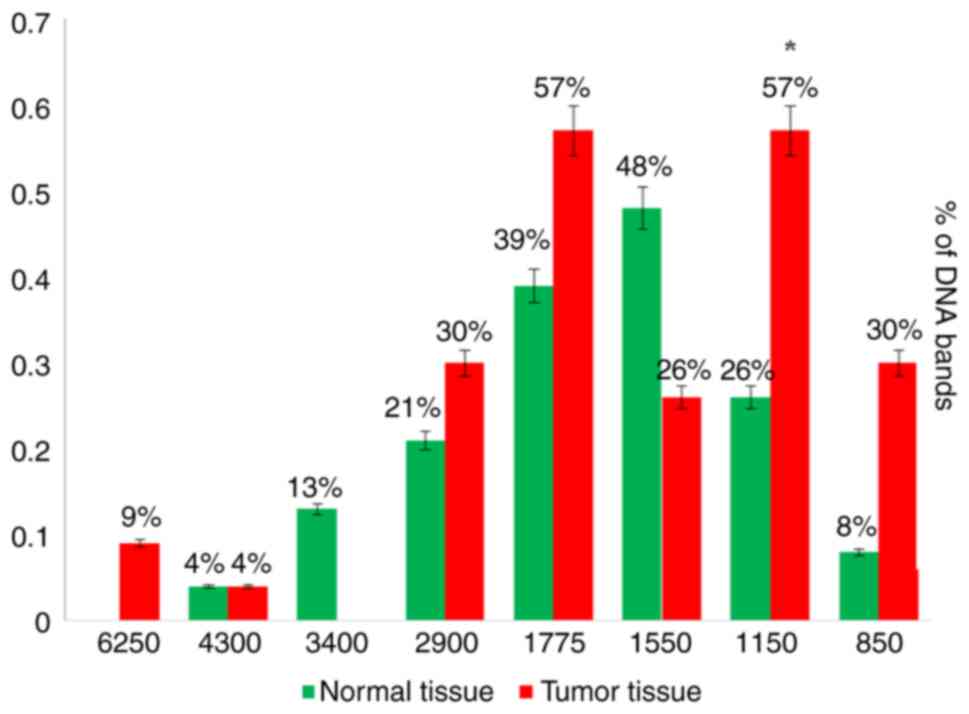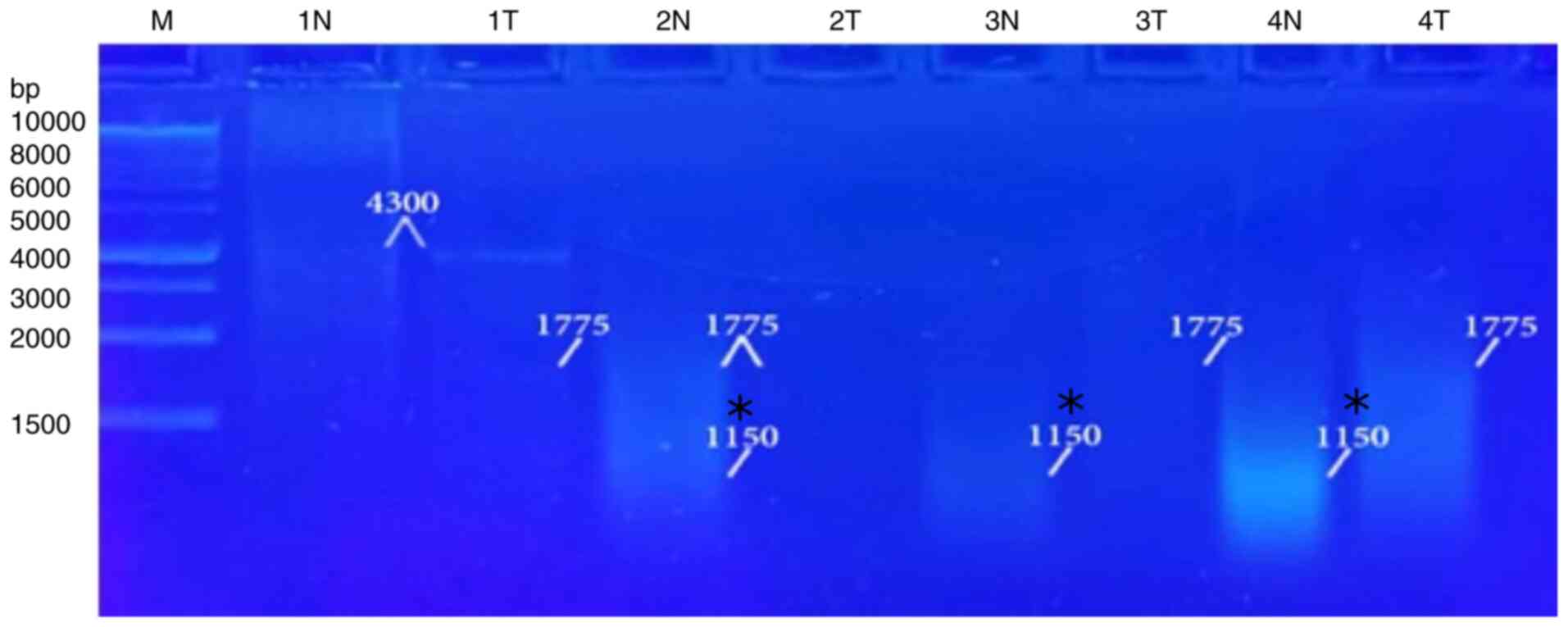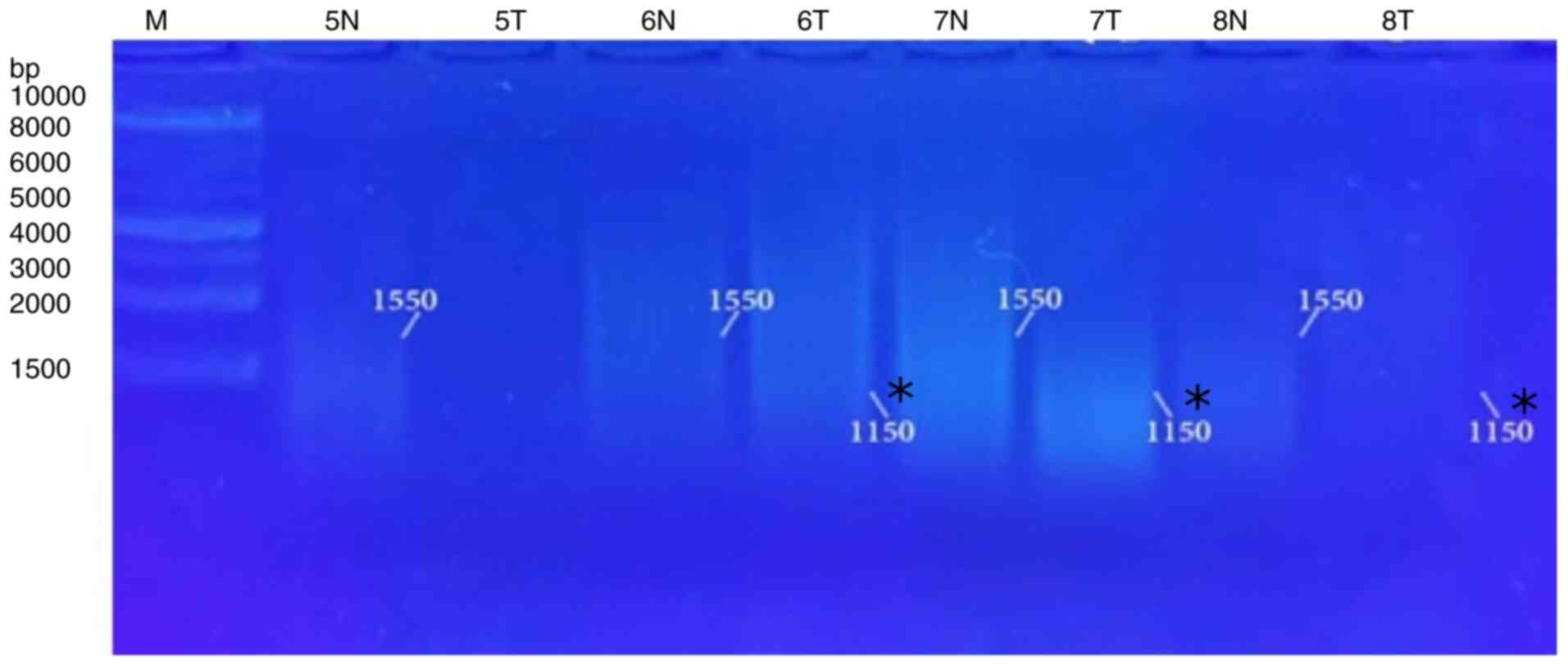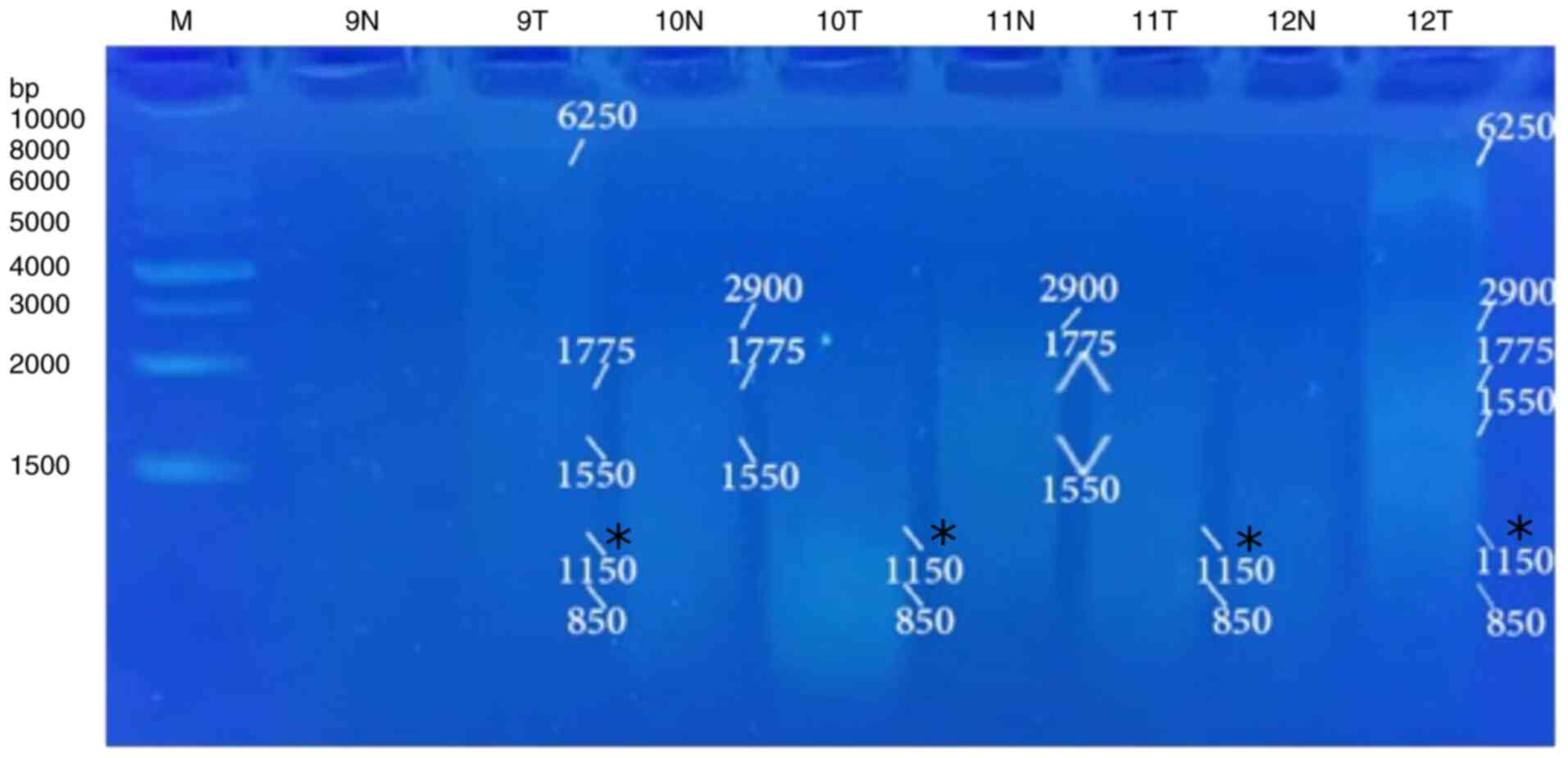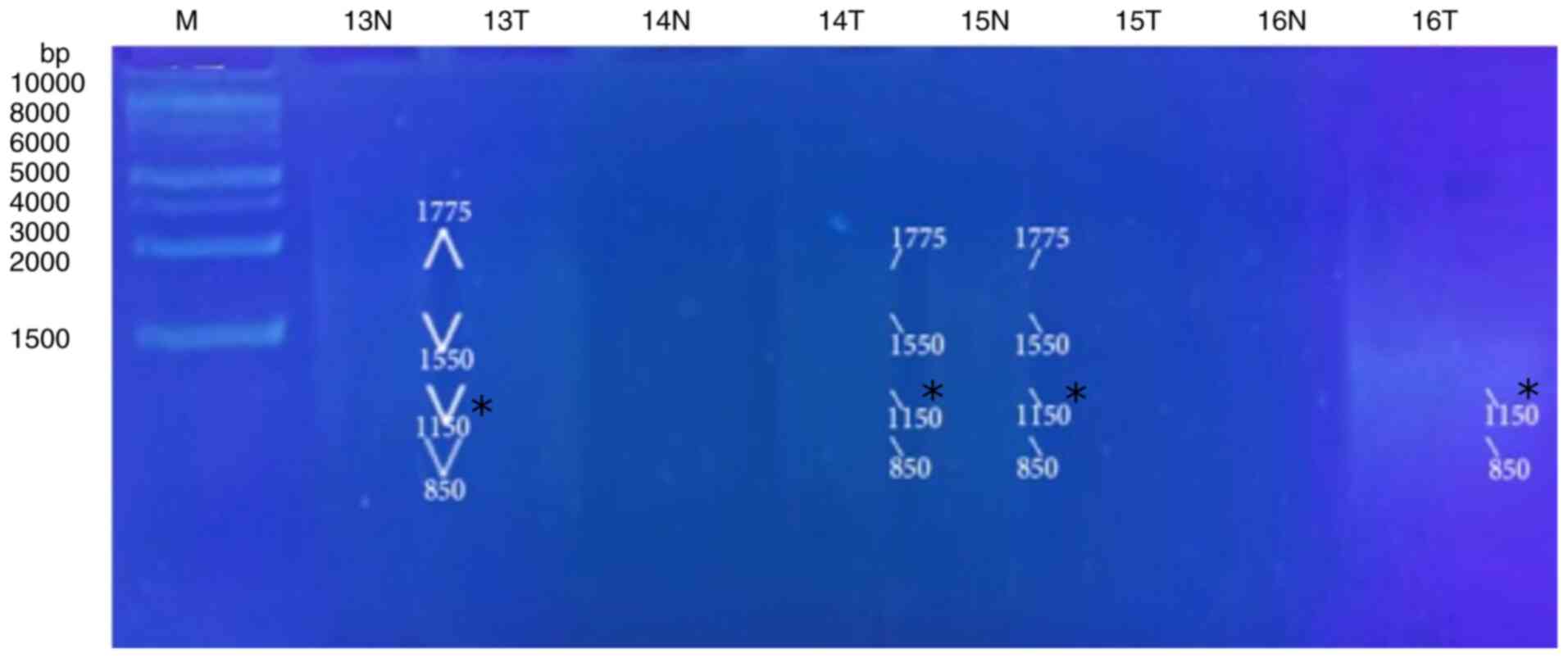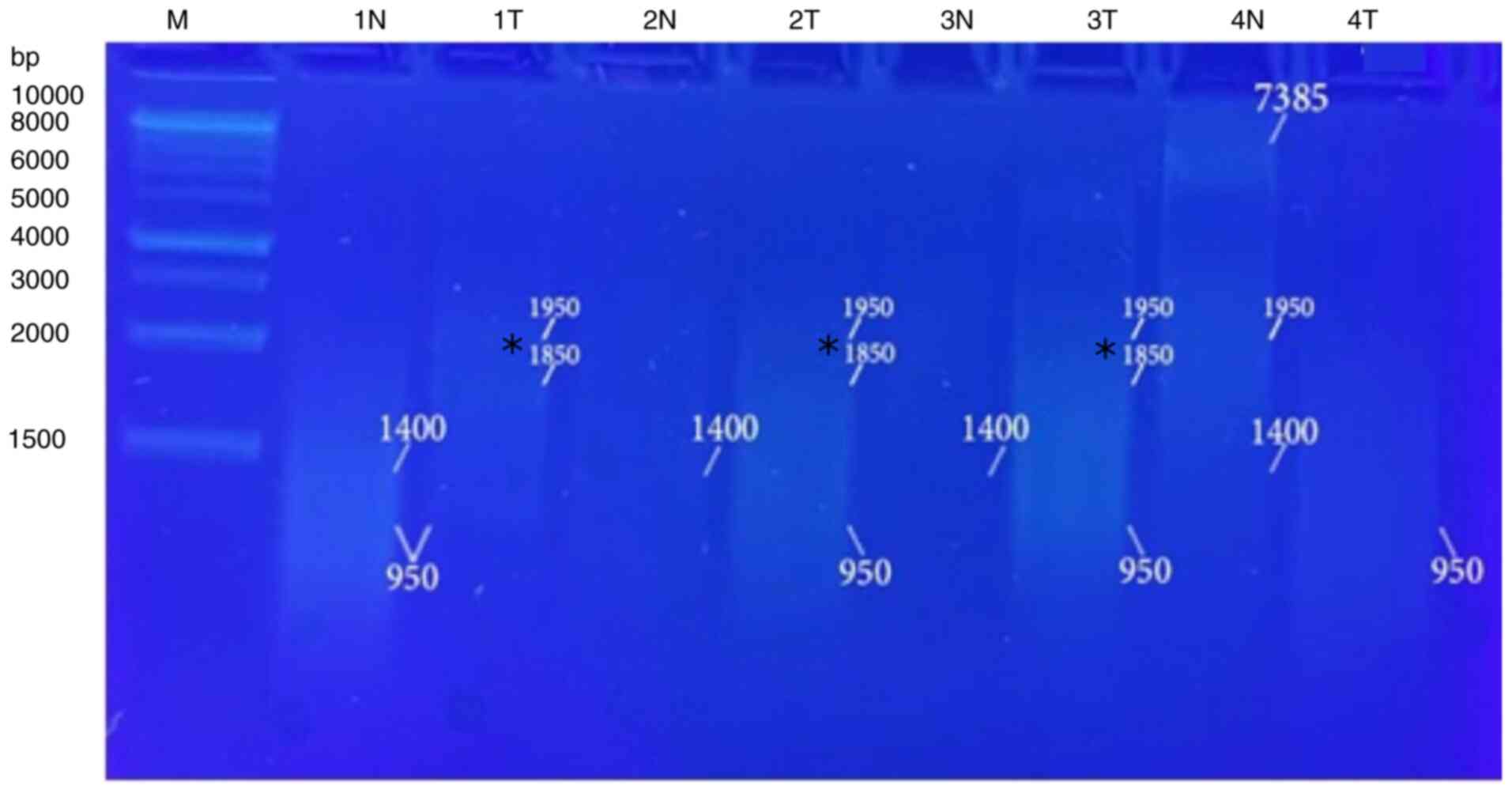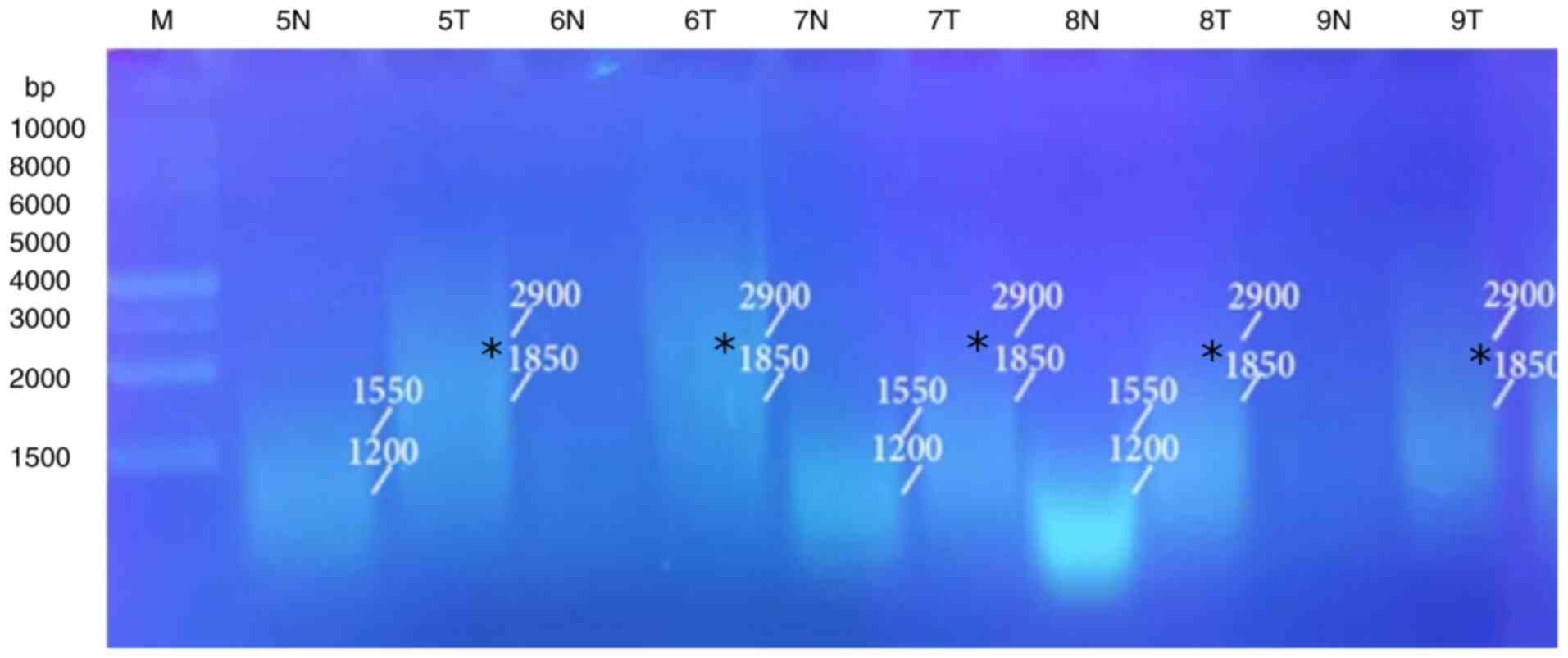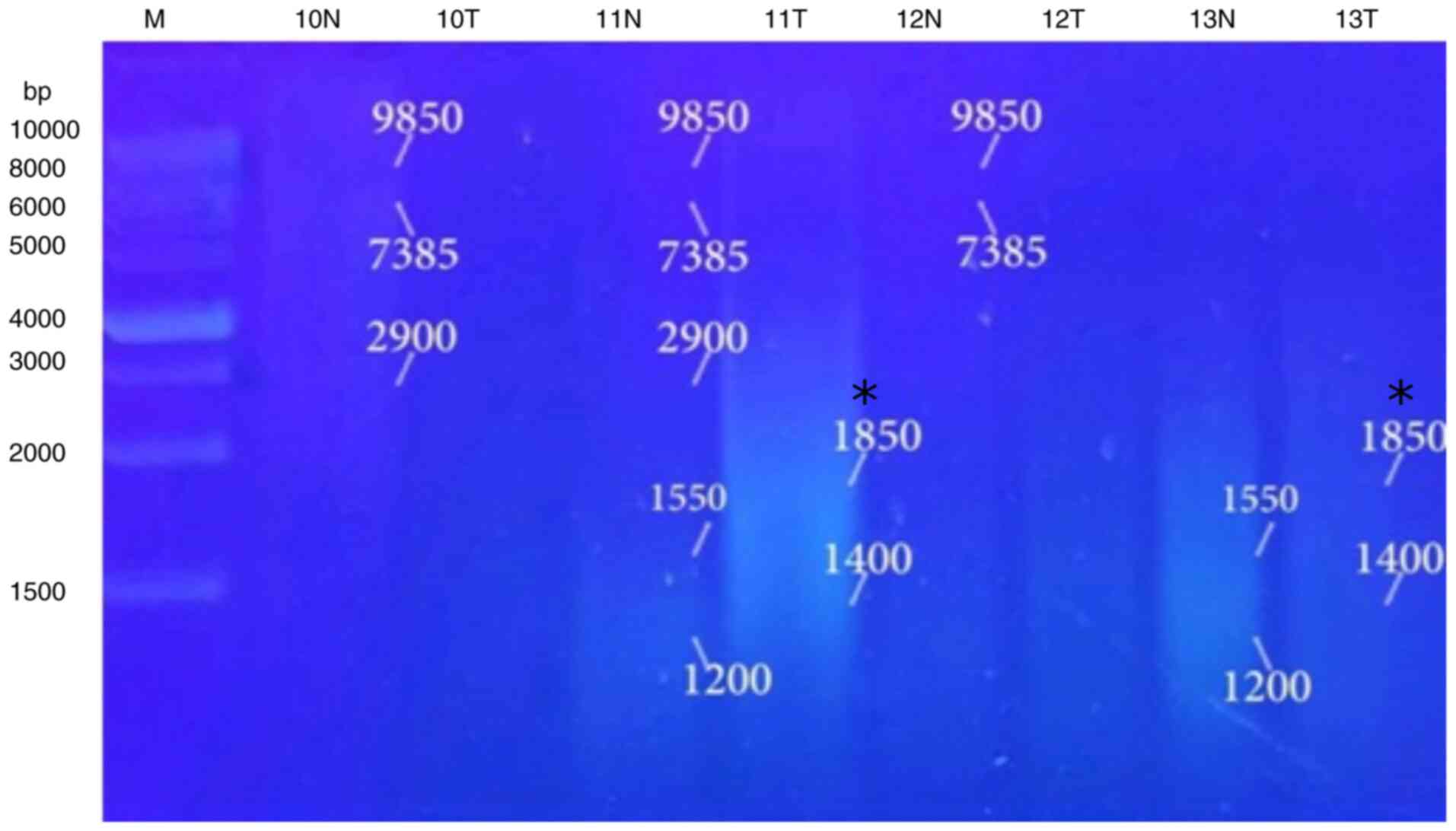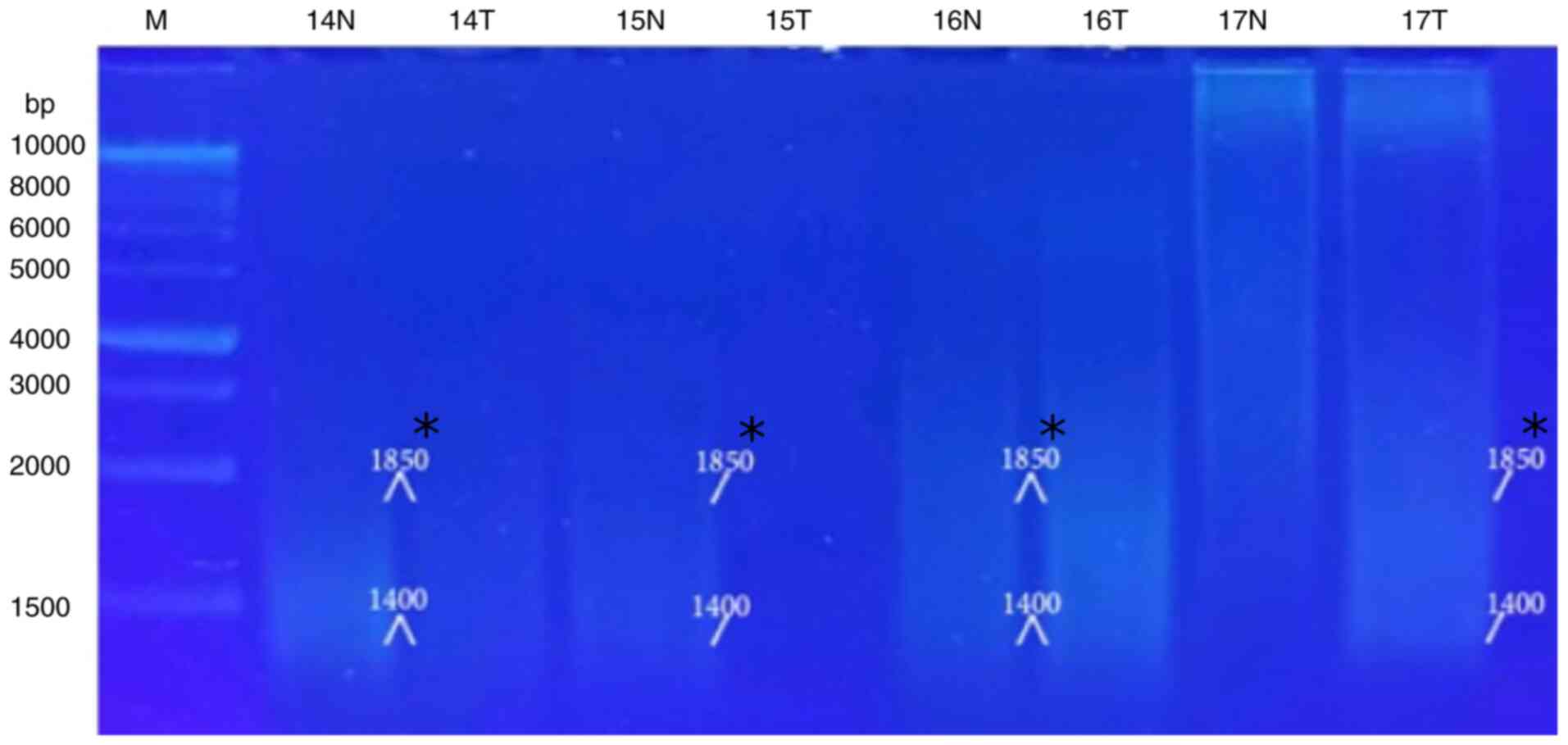Biochemical and molecular detection of genetic instability of liver cancer
- Authors:
- Published online on: November 19, 2024 https://doi.org/10.3892/wasj.2024.296
- Article Number: 8
-
Copyright : © Elmekawy et al. This is an open access article distributed under the terms of Creative Commons Attribution License [CC BY 4.0].
Abstract
Introduction
The liver is the largest organ of the mammalian body, with a highly varied and complex function. The role of the liver is demonstrated by the fact that despite intensive efforts, its action cannot be replaced by artificial technology. The liver contributes to the maintenance of the homeostasis of an organism as an active bidirectional biofilter. It is essential for protein, carbohydrate and fat metabolism in the human body (1). Liver cancer is associated with the third-highest mortality rate worldwide. The global mortality rate from liver cancer has reached 8.2%. The proper diagnosis of benign and malignant tumors is essential for effective treatment (2). Liver cancer is the fifth- and ninth-most prevalent malignancy among both males and females. It is the second-highest cause of cancer-related mortality worldwide. Furthermore, secondary liver cancer is more prevalent than primary liver cancer (3). Hepatocellular carcinoma (HCC) is a type of primary liver tumor that develops in a setting of chronic liver disease or cirrhosis. It has been responsible for the majority of liver cancer diagnosis and deaths. HCC is associated with a poor prognosis, with a 5-year survival rate of 20-40%, particularly in individuals with advanced-stage disease (4).
In Egypt, liver cancer is the fourth most frequent type of cancer. Numerous hospital researches have revealed an elevation in the incidence of HCC. This increased incidence may be due to the advanced technologies used for screening and diagnosis. These technologies increase the rate of survival of patients suffering from cirrhosis, those at risk of developing HCC, and hepatitis C virus (HCV)-related complications. The most common risk factor for developing liver cancer in Egypt, including HCC is HCV (5). Several liver function tests are performed on patients to assess and treat hepatic dysfunction. Alpha-fetoprotein (AFP) is the most commonly tested biomarker for monitoring HCC. Other benign or malignant illnesses can cause an increase in serum AFP levels. The specificity of AFP is hampered by its presence in other illnesses, such as hepatitis B virus (HBV), intrahepatic cholangiocarcinoma, and acute and chronic hepatitis (6).
The most effective techniques for identifying genomic areas involved in the control of traits of interest are molecular markers. They also make it easier to select target genomic regions based on marker genotype rather than concerned trait phenotype (7). For primer design, the random amplified polymorphic DNA (RAPD) approach does not require DNA probes or prior sequence information. As random primers are widely available, such sequence data information is irrelevant (8). However, RAPD analysis has certain limitations and disadvantages, such as the fact that almost all RAPD markers are dominant, i.e., it is not possible to distinguish whether a DNA segment is amplified from a locus that is heterozygous (1 copy) or homozygous (2 copies). The RAPD technique needs carefully developed laboratory protocols to be reproducible. In addition, the results from RAPD can be difficult to interpret. It lacks prior knowledge on the identity of the amplification products (9).
The use of RAPD has been shown to be successful in studying genetic polymorphisms of the specific breast cancer related genes (10). The genomic alteration of renal tumors was previously illustrated by RAPD analysis (11). RAPD-PCR analysis is used to identify genetic alterations and polymorphisms in human tumors, such as neck and head squamous cell carcinoma, lung cancer, ovarian cancer, lymphoma, brain tumors, HCC and leukemia (12). RAPD-PCR provides the potential to generate diagnostic markers for studying genomic instability in bladder tumors (13). RAPD has been used to identify a unique pattern of amplified DNA fragments in the genomic DNA of patients with acute lymphoblastic leukemia (14). Thus, the present study aimed to use RAPD to perform the biochemical and molecular detection of genetic instability in Egyptian patients with liver cancer, in order to aid in the medical diagnostic sector.
Patients and methods
Clinical specimens
After obtaining approval from the Medical Ethics Committee of Mansoura University (Mansoura, Egypt; approval no. MS.22.11.2211), the present prospective study was carried out on 20 patients with liver cancer. Informed consent was obtained for the publication of their data. Their ages were 45-80 years and they included both sexes (16 males and 4 females). They were selected randomly from the Gastroenterology Surgical Center, Mansoura University. The selected patients had no other malignant tumors. From April, 2022 to January, 2023, tissue true cut samples and blood samples were collected from patients with different grades and stages of liver cancer. From each liver cancer patient, tumor and normal tissues (as a self-negative control) were collected for the molecular analysis, while the blood samples were collected for the biochemical analysis.
Data collection
Patient data, including age and sex were collected from the files of the patients through the internal network of Gastroenterology Surgical Center, Mansoura University.
Histopathological characterization
Liver cancer histopathology of tissues biopsies including, tumor type, staging and grading was performed.
Etiological data
Data on viral infections, liver inflammation types and tumor classification were combined through virology reports.
Radiological examination
Patients with liver cancer underwent an abdominal ultrasound and a computerized tomography (CT) scan.
Biochemical analysis
Blood was collected from all the patients into different metal-free safety vacutainer blood-collecting tubes containing heparin (Kemico) for blood chemistry analysis, including serum creatinine (Creat), sodium (Na+), potassium (K+), glucose (Gluc), albumin (Alb), alanine transaminase (ALT), aspartate aminotransferase (AST), total protein (TP), total bilirubin (T.Bil) and AFP. The values of these tests were determined using a Cobas c311 autoanalyzer (Roche Diagnostics) and reagent cassettes were purchased from Roche Diagnostics Egypt. The second type of vacutainer blood-collecting tubes containing K2EDTA (Kemico) were used for the analysis of complete blood count (CBC), including red blood cells (RBCs), white blood cells (WBCs), platelets (PLTs) and hemoglobin level (Hb); these were measured using a Sysmex cell counter (Bioline 6500; Sysmex America, Inc.) and all the reagents were purchased from Sysmex, Egypt LLC. The third type of vacutainer blood-collecting tubes contained sodium citrate (3.2%) as an anti-coagulant (Greiener Bio-One) for the international normalized ratio (INR) test, and was measured using the Stago compact coagulation analyzer (Diagnostica Stago, Inc.) and all the reagents were purchased from Stago, Etico, Egypt. The normal references of all the biochemical tests were determined from the data sheet that was provided with the kit of each test.
Molecular analysis
Frozen true cut samples from tumor and normal tissues were weighed exactly and were grounded homogenously using a tissue homogenizer (Mechanika Precyzyjna, Poland; https://www.tachografy.kalisz.pl/kontakt/) and DNA was extracted by Phenol-chloroform isoamylalcohol manual method (15). The extracted genomic DNA concentration and purity were assessed by nanodrop spectrophotometer (Thermo Scientific 2000, USA). The optimum purity ratio was 1.8-2.0. Extracted pure genomic DNA integrity was assembled through gel electrophoresis in 0.7% agarose' (Industrias Roko S.A.). Agarose was boiled in a microwave for 2 min in 1X Tris Acetate EDTA (TAE) and mixed with 5 µl Midori Green Advance DNA stain (Nippon Corp.). The extracted genomic DNA was loaded in the prepared 0.7% agarose lanes and one lane (the first or last lane) was loaded with lambda/DNA HindIII marker (Sigma-Aldrich; Merck KGaA). Electrophoresis was performed in a gel electrophoresis apparatus (Labnet) for 45 min at 100 Vin 1XTAE, and demonstrated on ultraviolet light box (Fotodyne).
DNA amplification was carried out with five primers (A-01 to A-05) (Eurofins Genomics) to examine the efficiency of the primer kit (Table I). The PCR mixture was prepared in a 200 µl sterile PCR Eppendorf tube by mixing 1 µg pure genomic DNA, 2 U Taq DNA polymerase enzyme (Viviantis, Malizia; https://www.vivantechnologies.com/), 30 pm of each primer, one PCR bead (Enzynomics) and sterile (free of any salts and microorganisms) and distilled H2O was added to reach a final volume of 20 µl. The PCR Eppendorf was shaken and was spun at 13,000 rpm in an Eppendorf centrifuge (Beckman Coulter, Inc.). A total of 20 µl mineral oil (Merck KGaA) was dropped over the PCR mixture. The PCR Eppendorf containing the PCR components was transferred to the PCR machine (Proflex Industries Pte. Ltd.) which was programmed into three programs. The first program was cycled for 40 cycles; each cycle was programmed as four steps. The first step was set at 95˚C for 1 min to denature the DNA (initial), the second step was set at 95˚C for 1 min to denature the DNA (final), the third step was set at 30˚C for 1 min to anneal the primer with DNA strands, and the fourth step was set at 72˚C for 2 min for the new DNA extension. The first program was linked to the second program, which was set as one cycle at 72˚C for 7 min for the final extension of the new DNA copies. The second program was linked to the third program, which was programmed to terminate the reaction by keeping the PCR Eppendorf tube at 4˚C in the PCR machine. The results of RAPD-PCR were analyzed through gel electrophoresis as previously described (highlighted green) with some modifications: The agarose gel was prepared as 2%, and the DNA marker (GeneDirex) was a 1-kb DNA ladder. DNA bands molecular weights were calculated using GellApp software 1.2.7 android app.
Statistical analysis
GraphPad Prism 5.0 software (Dotmatics) was used for all statistical analyses. The results were presented as the mean ± the standard error of the mean (SEM) (n=6), where n is the number of patients in each group. One-way analysis of variance (ANOVA) was used to perform statistical comparisons followed by the Student-Newman-Keuls post hoc test (16). The Chi-squared test and Fisher's exact test (<20 cases) were used to analyze the association between genomic instability, histological type and the grade of liver cancer. A value of P<0.05 was considered to indicate a statistically significant difference. The GellApp analyzer program was used to determine the molecular weight of the amplified DNA fragments including normal and tumor DNA bands by plotting a curve illustrating the detected fragment molecular weight against the molecular weight of the marker fragments.
Results
According to the ages and sex of the patients, the incidence of liver cancer among the male patients was ~4-fold higher compared with that among the female patients and the age range of the patients was 45-80 years (Table II). A histopathological examination of the tumor tissues biopsies was performed, revealing that HCC comprised the highest frequency (85%) followed by fibrolamellar carcinoma (10%), while hepatic adenoma (rare type) exhibited the lowest percentage (5%) (Table III). As regards tumor grading and staging, grade II exhibited the highest frequency (80%) followed by grade III (15%) and grade I (5%) (Table IV), while the majority of patients (40%) had stage I disease followed by stage III (30%) and stage II (20%); only a minority of patients (10%) had stage IV disease (Table V). As regards the liver cancer etiology of the patients, ~50% of patients had fatty liver cirrhosis, 10% of patients had HBV and 40% of patients had HCV. According to radiological analyses, when patients underwent radiological investigations, it was found that the majority of the patients (85%) had large-sized tumors and the remaining (15%) of patients had smaller-sized tumors. On the other hand, the majority of the patients (50%) were suffering from fatty liver cirrhosis, while in 10% of patients, the lymph nodes were invaded by the tumor (metastasis) and the remaining 90% of the patients did not have lymph node metastasis (Table VI).
Biochemical analysis of the patients with liver cancer included chemical and hematological analyses. Chemical analysis revealed a significant decrease in both serum Alb and Na+ levels. A significant increase in serum Bil, Creat, K+, AFP, ALT and AST levels was recorded in the tumor tissues compared with the normal tissues (Table VII and Fig. 1). Hematological parameters included CBC and INR analyses of the patients with liver cancer. The CBC analyses exhibited a significant decrease in the RBC count, PLT count and Hb content in the tumor tissues compared with the normal control values, whereas the WBC count was significantly increased in the tumor tissues compared with the normal tissues. Moreover, the INR level exhibited a significant increase in the tumor tissues (Table VII and Fig. 2).
The results of molecular analysis included extracted genomic DNA profile and RAPD-PCR pattern profile. Purified extracted DNA of the patients with liver cancer was run on 0.7% agarose gels (Fig. 3). RAPD-PCR was used for analysis with five distinct primers of A-01 to A-05 (Table I). Two primers (A-01 and A-03) were amplified and presented clear and firm bands with the majority of the tested samples. The A-01 primer revealed several bands and eliminated others when used in the RAPD-PCR approach. A 6,250-bp band was observed in 9% of the tumor tissue samples and was completely absent in all the normal tissue samples. While it was presented in 13% of all the normal tissue samples, the 3,400-bp band was completely absent from all the malignant tissue samples. In 4, 21, 39, 48 and 8%, respectively of the normal tissue samples, and in 4, 30, 57, 26 and 30%, respectively of the tumor tissue samples, five common bands 4,300, 2,900, 1,775, 1,550 and 850 bp were observed. A distinctive significant appearance (P=0.036071) of a tumor marker band of 1,150 bp in 26% of the normal tissue samples, and in 57% of the tumor tissue samples was noted (Fig. 4, Fig. 5, Fig. 6, Fig. 7 and Fig. 8 and Table VIII). When primer the A-03 was employed in the RAPD-PCR approach, four bands of 9,850, 7,385, 1,550 and 1,200 bp were detected in 18, 24, 29 and 29%, respectively of all the normal tissue samples however; they were completely absent from all malignant tissue samples. The four common bands 2,900, 1,950, 1,400 and 950 bp were found in 6, 6, 41 and 6 of the normal tissue samples, respectively, and in 29, 18, 29 and 24% of the tumor tissue samples, respectively. A highly significant appearance (P=0.000591) of a tumor marker band of 1,850 bp was observed in 24% of the normal tissue samples, and in 82% of the tumor tissue samples (Fig. 9, Fig. 10, Fig. 11, Fig. 12 and Fig. 13 and Table IX).
Table VIIIStatistical analysis of amplified DNA fragments generated using the A-01 primer for liver tumor and normal tissues. |
Table IXStatistical analysis of amplified DNA fragments which generated by A-03 primer of liver tumor and normal tissues. |
Discussion
In the present study, the ages of the patients ranged between 45-80 years and included both sexes, where the male sex was ~4-fold more common than females combined with a previous hypothesis (17,18). In addition, the present study demonstrated that the HCC type comprised the highest frequency (85%) followed by the mixed type (15%) and fibrolamellar carcinoma (10%), while hepatic adenoma (rare type) was the lowest percentage (5%). Another study indicated that 75-85% of cases were HCC, followed by intrahepatic cholangiocarcinoma and the remaining cases were less common tumors; grade II liver cancer comprised the majority of cases (80%), while grade I cancer comprised the minority (5%) (19). On the contrary, previous research has revealed a significantly high percentage of grade I and a low percentage of grade III liver cancer tumors (20).
Compared to previous findings, the present study demonstrated that 40% of the patients were in stage I, while in another study, only 4.6% of patients had stage I disease (21). The present study conducted the radiological analysis of patients with liver cancer using CT scan and abdominal ultrasound. It was revealed that 85% of the patients had large-sized tumors and the remaining 15% had smaller-sized tumor. To a certain extent, these results are in accordance with the findings of another study where 25% of the liver cancer lesions are <3 cm and 50% of the tumors were >3 cm in diameter (22). The present study found that fatty liver cirrhosis comprised 50% of the cases, HBV comprised 10% and HCV comprised 40% of the cases. Of note, in another study, 95.7% of the cases had HCV or HBV infection, with the incidence of HCV predominating (91.4%) (23). Egypt has the highest HCV prevalence rate worldwide, with rates of 6 to 28% (23). The hematological findings of patients with liver cancer have been demonstrated in previous studies (24-26); in these patients, RBCs, the PLT count and Hb content were significantly decreased compared to normal values, while the number of WBCs was significantly increased (24-26). Previous studies (27,28) have confirmed the biochemical observations of the present study where, serum Alb and sodium levels were significantly decreased in the serum of patients with liver cancer compared to normal values. However, the values of serum T.Bil, serum Creat, potassium, serum AFP, serum ALT, AST and the plasma INR were all significantly elevated and this finding has been corroborated by previous studies (29-34).
The present study used the RAPD-PCR approach to demonstrate the genomic instability of Egyptian patients suffering from liver cancer by losing normal bands and revealing new tumor-related bands. Additionally, other researchers have supported these findings, where the RAPD investigation of patients with HCC revealed loss or gain of bands, change in intensity and shifting in DNA band/s of the tumor lane compared to the corresponding healthy DNA (35). Genetic alterations were revealed in HCC that were discovered by one primer at least, and the genetic mutations detectability was ranged from 20 to 70% in each instance and 17.9 to 50% of each primer (12). In a previous study on CCA, the RAPD analysis of chromosomes 2p25.3 and 7q11.23 appeared consistent DNA fingerprints of tumor and normal tissue from the same patient. Normal and tumor bands intensities were compared to examine changes in DNA fingerprints (36). Furthermore, that study discovered that the amplified CCA accounted for >70% of the alterations in the genome. The significant prevalence gain of the CCA sequence may suggest that changes in gene copy numbers play a crucial role in this type of cancer (36).
In the present study, the RAPD-PCR analysis of the tumors of patients with liver cancer and normal tissues by using the A-01 primer revealed promising results, when a distinctive significant appearance (P=0.036071) of a tumor marker band of 1,150 bp appeared in 26% of the normal tissue samples and in 57% of tumor tissue samples. Another notable result was observed with the A-03 primer, where a highly significant appearance (P=0.000591) of a tumor marker band of 1,850 bp was observed in 24% of the normal tissue samples and in 82% of the tumor tissue samples. A number of DNA bands appeared in the tumor and/or normal tissues; however, none of these produced any significant findings.
In conclusion, the present study performed biochemical, hematological, histopathological and radiological analyses examine the phenotype of the cell. Thus, sharp and accurate technology acting on the genotype of the cancer cell, such as RAPD-PCR, is required to discover genetic instability. The present study indicated that RAPD-PCR analysis succeeded in producing diagnostic marker primers (A-01 and A-03) and tumor marker bands specific for liver cancer. The present study provides evidence of the potential promise of RAPD-PCR analysis as a diagnostic molecular genetic marker technology, apart from the traditional diagnostic approaches. However, the present study was a preliminary study, and thus further studies are required in the future to confirm these findings.
Acknowledgements
Not applicable.
Funding
Funding: No funding was received.
Availability of data and materials
The datasets used and/or analyzed during the current study are available from the corresponding author on reasonable request.
Authors' contributions
AZM conceived the study, managed the manuscript and performed the RAPD-PCR technique. EKA performed the hematological and biochemical analyses. AMA provided the tissue samples and analyzed the medical reports. SFE performed the statistical analysis and confirmed the authenticity of the raw data. All authors have read and approved the final manuscript. AZM and EKA confirm the authenticity of the raw data.
Ethics approval and consent to participants
On April 8, 2023, informed consent was obtained from all participants and/or their legal guardians, while approval was obtained from the Ethics Committee of the Faculty of Medicine, Mansoura University, Mansoura, Egypt (Approval no. MS.22.11.2211). All methods were performed in accordance with the relevant guidelines.
Patient consent for publication
Not applicable.
Competing interests
The authors declare that they have no competing interests.
References
|
Arias IM, Alter HJ, Boyer JL, Cohen DE, Shafritz DA, Thorgeirsson SS and Wolkoff AW: The Liver: Biology and Pathobiology. 6th edition. Wiley-Blackwell, Hoboken, NJ, 2020. | |
|
Pan F, Huang Q and Li X: Classification of liver tumors with CEUS based on 3D-CNN. In: 2019 IEEE 4th international conference on advanced robotics and mechatronics (ICARM). IEEE 845-849, 2019. | |
|
Wang ZG, He ZY, Chen YY, Gao H and Du XL: Incidence and survival outcomes of secondary liver cancer: A surveillance epidemiology and end results database analysis. Transl Cancer Res. 10:1273–1283. 2021.PubMed/NCBI View Article : Google Scholar | |
|
Shannon AH, Ruff SM and Pawlik TM: Expert insights on current treatments for hepatocellular carcinoma. Clinical and molecular approaches and bottlenecks to progress. J Hepatocell Carcinoma. 9:1247–1261. 2022.PubMed/NCBI View Article : Google Scholar | |
|
Rashed WM, Kandeil MAM, Mahmoud MO and Ezzat S: Hepatocellular carcinoma (HCC) in Egypt. A comprehensive overview. J Egypt Natl Can Inst. 32(5)2022.PubMed/NCBI View Article : Google Scholar | |
|
Piñero FF, Dirchwolf M and Pessôa MG: Biomarkers in hepatocellular carcinoma: Diagnosis, prognosis and treatment response assessment. Cells. 9(1370)2020.PubMed/NCBI View Article : Google Scholar | |
|
Jahnke G, Smidla J and Poczai P: MolMarker: A simple tool for DNA fingerprinting studies and polymorphic information content calculation. Diversity. 14(497)2022. | |
|
Al-Samarai FR and Al-Kazaz AA: Molecular markers: An introduction and applications. Eur J Mol Biotechnol. 9:118–130. 2015. | |
|
Senthil N and Gurusubramanian G: Random amplified polymorphic DNA (RAPD) markers and its applications. Sci Vis. 11:116–124. 2011. | |
|
Allami ZZG and Dragh MA: Identification of some breast cancer related genes by RAPD technique in Maysan Province Iraq. Revis Bionatura. 7:20–28. 2022. | |
|
El-Far M, Abol-Enein H, Zakaria A and El-Gedamy M: Detection of genomic instability in renal cancer by random amplified polymorphic DNA analysis from urine samples as a non-invasive method: Potential use in diagnosis. Cancer Sci Res. 1(7)2013. | |
|
Xian ZH, Cong WM, Zhang SH and Wu MC: Genetic alterations of hepatocellular carcinoma by random amplified polymorphic DNA analysis and cloning sequencing of tumor differential DNA fragment. World J Gastroenterol. 11:4102–4107. 2005.PubMed/NCBI View Article : Google Scholar | |
|
El-Far M, Abol-Enein H, Zakaria A and El-Gedamy M: Application of random amplified polymorphic DNA-PCR technique in early diagnosis of bladder cancer using urine samples. Curr Top Bio Res. 15:23–34. 2013. | |
|
Ibrahim MA, Saleh NA, Archoukieh E, Al-Obaide HW, Al-Obaidi MM and Said HM: Detection of novel genomic polymorphism in acute lymphoblastic leukemia by random amplified polymorphic DNA analysis. Int J Cancer Res. 6:19–26. 2010. | |
|
Zakaria A and Mahmoud AZ: Molecular characterization of TP53 gene mutations in human bladder cancer. Pharm Biotechnol. Curr Res. 2:1–7. 2017. | |
|
Armitage P, Berry G and Matthews JNS: Statistical Methods in Medical Research. 4th edition. Wiley-Blackwell, Hoboken, NJ, 2002. | |
|
Bale R, Schullian P, Eberle G, Putzer D, Zoller H, Schneeberger S, Manzl C, Moser P and Oberhuber G: Stereotactic radiofrequency ablation of hepatocellular carcinoma: A histopathological study in explanted livers. Hepatology. 70:840–850. 2019.PubMed/NCBI View Article : Google Scholar | |
|
Suresh D, Srinivas AN and Kumar DP: Etiology of hepatocellular carcinoma: Special focus on fatty liver disease. Front Oncol. 10(601710)2020.PubMed/NCBI View Article : Google Scholar | |
|
Loy LM, Low HM, Choi JY, Rhee H, Wong CF and Tan CH: Variant hepatocellular carcinoma subtypes according to the 2019 WHO classification: An imaging-focused review. AJR Am J Roentgenol. 219:212–223. 2022.PubMed/NCBI View Article : Google Scholar | |
|
Martins-Filho SN, Paiva C, Azevedo RS and Alves VAF: Histological grading of hepatocellular carcinoma-A systematic review of literature. Front Med. 4(193)2017.PubMed/NCBI View Article : Google Scholar | |
|
Szklaruk J, Silverman PM and Charnsangavej C: Imaging in the diagnosis, staging, treatment, and surveillance of hepatocellular carcinoma. AJR Am J Roentgenol. 180:441–454. 2003.PubMed/NCBI View Article : Google Scholar | |
|
Elgamal S, Ghafar AA, Ghoneem E, Elshaer M, Alrefai H and Elemshaty W: Characterization of patients with hepatocellular carcinoma on the way for early detection: One center experience. Egypt J Int Med. 30:231–238. 2018. | |
|
Omar M, Elazab T, Abdelrahman A and Mohamed E: Clinical significance of serum midkine level as a biomarker in diagnosis of hepatocellular carcinoma. Benha Med J (Internal Med Hepatol) Special Issue. 37:37–46. 2020. | |
|
Fang Y, Sun X, Zhang L, Xu Y and Zhu W: Hemoglobin/red blood cell distribution width ratio in peripheral blood is positively associated with prognosis of patients with primary hepatocellular carcinoma. Med Sci Monit. 28:e937146–1. 2022.PubMed/NCBI View Article : Google Scholar | |
|
Newsome PN, Cramb R, Davison SM, Dillon JF, Foulerton M, Godfrey EM, Hall R, Harrower U, Hudson M, Langford A, et al: Guidelines on the management of abnormal liver blood tests. Gut. 67:6–19. 2018.PubMed/NCBI View Article : Google Scholar | |
|
Mohamed BF, Serag WM, Abdelal RM and Elsergany HF: S100A14 protein as diagnostic and prognostic marker in hepatocellular carcinoma. Egypt Liver J. 9:1–6. 2019. | |
|
Carr BI and Guerra V: Serum albumin levels in relation to tumor parameters in hepatocellular carcinoma patients. Int J Biol Markers. 32:e391–e396. 2017.PubMed/NCBI View Article : Google Scholar | |
|
Nishikawa H, Kita R, Kimura T, Ohara Y, Sakamoto A, Saito S and Osaki Y: Hyponatremia in hepatocellular carcinoma complicating with cirrhosis. J Cancer. 6:482–489. 2015.PubMed/NCBI View Article : Google Scholar | |
|
Guerra Ruiz AR, Crespo J, LópezMartínez RM, Iruzubieta P, Casals Mercadal G, Lalana Garcés M and Morales Ruiz M: Measurement and clinical usefulness of bilirubin in liver disease. Adv Lab Med. 2:352–361. 2021.PubMed/NCBI View Article : Google Scholar | |
|
Watanabe M, Yokomori H, Takahashi Y, Okada T, Shibuya A and Koizumi W: Assessing the characteristics and feasibility of preventing early mortality in patients with hepatocellular carcinoma. The Turkish J Gastroenterol. 30:541–548. 2019.PubMed/NCBI View Article : Google Scholar | |
|
Singh Y, Nagar D, Singh M and Maroof M: Study of electrolyte disturbance in chronic liver disease patients attending a hospital in Kumaon region. J Family Med Primary Care. 11:4479–4482. 2022.PubMed/NCBI View Article : Google Scholar | |
|
Zhang J, Chen G, Zhang P, Zhang J, Li X, Gan DN and Ye YA: The threshold of alpha-fetoprotein (AFP) for the diagnosis of hepatocellular carcinoma: A systematic review and meta-analysis. PLoS One. 15(e0228857)2020.PubMed/NCBI View Article : Google Scholar | |
|
Chen W, Wang W, Zhou L, Zhou J, He L, Li J, Xu X, Wang J and Wang L: Elevated AST/ALT ratio is associated with all-cause mortality and cancer incident. J Clin Lab Anal. 36(e24356)2022.PubMed/NCBI View Article : Google Scholar | |
|
Zhang H, Gao C, Fang L and Yao SK: Increased international normalized ratio level in hepatocellular carcinoma patients with diabetes mellitus. World J Gastroenterol. 19:2395–2403. 2013.PubMed/NCBI View Article : Google Scholar | |
|
Zhang SH, Cong WM, Xian ZH, Dong H and Wu MC: Genomic instability in hepatocellular carcinoma revealed by using the random amplified polymorphic DNA method. J Cancer Res Clin Oncol. 130:757–761. 2004.PubMed/NCBI View Article : Google Scholar | |
|
Chariyalertsak S, Khuhaprema T, Bhudisawasdi V, Sripa B, Wongkham S and Petmitr S: Novel DNA amplification on chromosomes 2p25.3 and 7q11.23 in cholangiocarcinoma identified by arbitrarily primed polymerase chain reaction. J Cancer Res Clin Oncol. 131:821–828. 2005.PubMed/NCBI View Article : Google Scholar |



